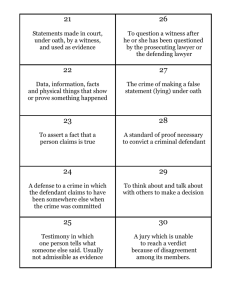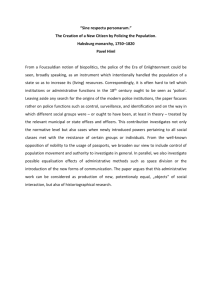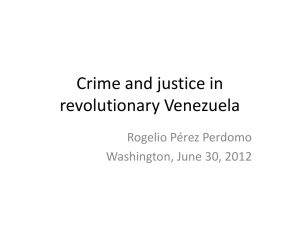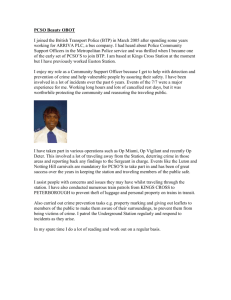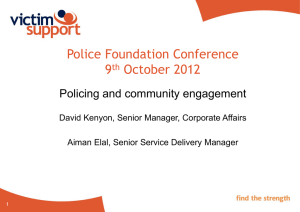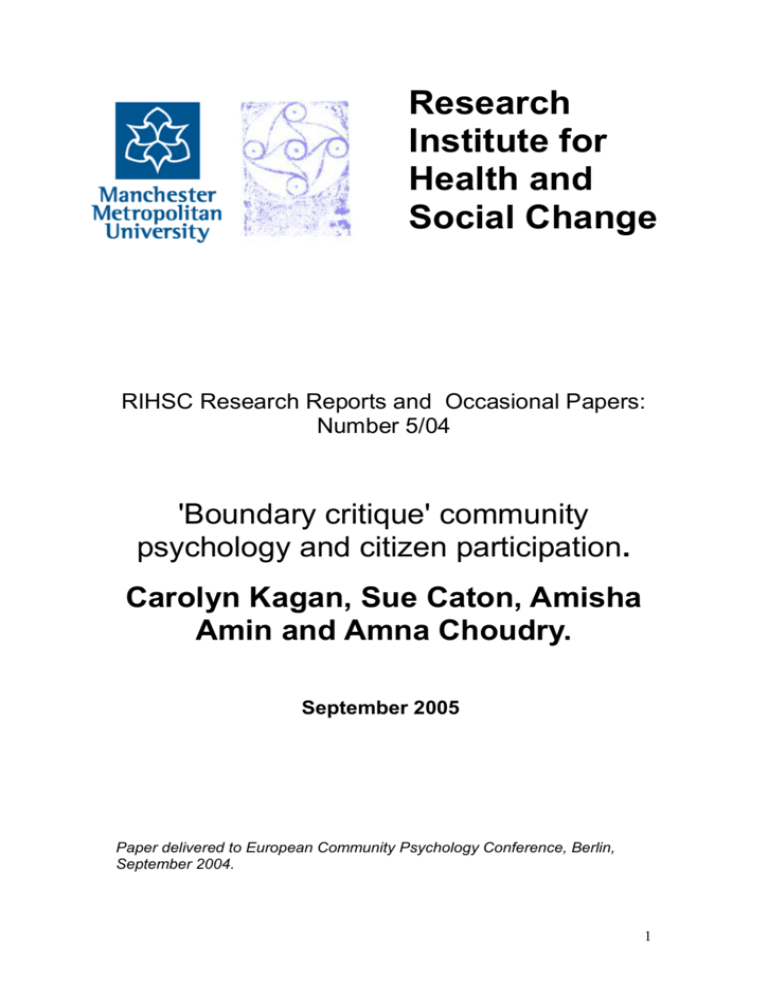
Research
Institute for
Health and
Social Change
RIHSC Research Reports and Occasional Papers:
Number 5/04
'Boundary critique' community
psychology and citizen participation.
Carolyn Kagan, Sue Caton, Amisha
Amin and Amna Choudry.
September 2005
Paper delivered to European Community Psychology Conference, Berlin,
September 2004.
1
2
Published by: RIHSC: the Research Institute for Health and Social Change (formerly
COP Research Group)
Copyright (c) 2004 RIHSC: Research Institute for Health and Social Change
All rights reserved.
No part of this work may be reproduced by any means, or transmitted, or translated
into a machine language without the written permission of the RIHSC: Research
Institute for Health and Social Change, unless under the terms of the Copyright
Licensing Agreement, or for use in Education, or for dissemination within an
organisation in which case the work must be reproduced in its entirety with
acknowledgement of the RIHSC: Research Institute for Health and Social Change.
RIHSC Research Reports and Occasional Papers
Published occasionally by the RIHSC: Research Institute for Health and Social
Change
For information contact the publishers at the address below
ISSN 1359-9089
ISBN 1-900139- 56-1
Printed by the Manchester Metropolitan University
RIHSC: Research Institute for Health and Social Change:
RIHSC is a centre of international excellence and innovation in critical research and
consultancy on social change, social inclusion, community participation, well-being,
work and leisure, health and social care practices and policies, and the clinical
biomedical, behavioural and forensic sciences.
RIHSC: Research Institute for Health and Social Change
Manchester Metropolitan University
Elizabeth Gaskell Campus
Hathersage Road
Manchester
M13 0JA
Tel:
0161 247 2563/2556/2595
Fax: 0161 247 6364
Email: C.Kagan@mmu.ac.uk or
3
Abstract
In an area of an inner city in the UK, population turnover was high, housing
was poor, there were many derelict areas, work was in short supply, school
absences were high and facilities in the area had declined.. An area analysis,
raised significant issues in relation to crime; education; health and well-being;
worklessness; physical environment; local services; and community capacity
and cohesion. Within the consultation exercise undertaken as part of the
Regeneration plan, crime emerged as the most significant concern for
residents.
72% of residents rated their area as unsafe and 47% think the area
is less safe than it was two years ago;
Although the area comprises approximately 2.7% of the City
population, it comprised 8% of burglaries from dwellings, 8.7% of
criminal damage and 14.6% of arson;
Fear of crime is higher than crime itself;
Levels of reporting of crime were extremely low.
Work was undertaken with local residents’ groups and other stakeholders to
explore local peoples experiences of crime, fear of crime and intimidation and
agency (especially the police) responses to the reporting of crime.
Barriers and supports to acting as a witness at different stages of the process
were identified and these were contextualised in a large amount of local
regeneration activity, general perceived lack of confidence in the police; some
strong community organisations, but also some insularity and isolation; strong
perceptions of ‘outsiders’; and a relative lack of involvement of young people
in finding solutions for the area.
A participative process was used to identify ways in which a’ cycle of
negativity’ within the area could be broken. Unanticipated blocks to
implementation are explored with reference to the theory and practice of
boundary critique.
Introduction
In community psychology there is wide agreement that the ecological
metaphor is a useful one. This encourages us to do two things. Firstly it
encourages us to understand the importance of context for understanding
behaviour, experience and change and to develop context interventions in
order to facilitate change. Secondly it encourages us to understand the
complexity of social situations and social and societal contexts as complex
systems - multi-level and multi-dimensional systems.
In some of our previous work we have drawn on the work of soft systems and
critical systems methodologies to plan, implement and understand change
(Kagan et al., 2003; Midgley et al., 2002; Boyd et al., 2001). Critical systems
thinking (CST) is, according to Midgley (1996) based around three themes for
debate: critical awareness (examining and re-examining assumptions and the
conditions that give rise to them), improvement (taking issues of power into
account) and methodological pluralism (using a variety of research methods in
4
theoretically coherent ways and becoming aware of their strengths and
weaknesses).
In terms of critical awareness, the concept of boundary critique is useful.
Boundary critique (BC) involves
Maintaining a stance of critical awareness … considering the different
possible boundaries that might be used in analyses, and taking account of
their possible consequences for intervention (Midgley, Munro and Brown,
1998:467)
In this paper we will take a piece of community psychological action research
and explore the use of BC as a means of a) improving community involvement
in decision making, and b) an aid to understand how decision making
occurred. We will explore the utility of BC is helping us make ethical and
critical judgements about our community psychological work.
The action research project
The problem and location of the project
The project was part of a complex and large regeneration scheme in a City in
the north of the UK. 'Heartlands' (population 11,231) is an area which
…rank(s) amongst the poorest and most disadvantaged areas in the
country, suffering from a wide range of problems on a scale that has
created deep-seated deprivation and instability. (Heartlands Delivery
Plan, 1999)
Population turnover is high, housing is poor, there are many derelict areas,
work is in short supply, school absences are high and facilities in the area are
declining. An area analysisi, raised significant in relation to crime; education;
health and well-being; worklessness; physical environment; local services;
and community capacity and cohesion. Within the consultation exercise
undertaken as part of the New Deal plan, crime emerged as the most
significant concern for residents. These can be summarised as follows ii:
72% of residents rate their area as unsafe and 47% think the area is
less safe than it was two years ago;
The NDC area comprises approximately 2.7% of the City of
Manchester population, but comprises 8% of burglaries from
dwellings, 8.7% of criminal damage and 14.6% of arson;
Fear of crime is higher than crime itself;
There are high levels of crime that impact on the whole community,
such as vandalism, breaking into empty properties, abandoning
stolen cars;
57% of elderly will not walk in the area after dark and 25% of people
feel unsafe at home alone after dark;
58% rate the support from the police as fairly or very bad;
63% identify lack of police presence as a problem.
5
There is a general perception that minor crime is tolerated, leading
to a decline in the confidence in enforcement and targeting of the
area by criminals living within and outside the area.
Repeat victimisation is high;
anti-social and neighbour nuisance are major concerns for many
residents;
40% have suffered from unreasonable noise in or around their
home, and 35% have suffered frequently from abusive language;
teenagers and young people are felt by 77% to be the main cause of
problems;
racial harassment is not thought to be a problem, although 8% of
ethnic minority groups have suffered frequently;
The outcomes planned as a result of the regeneration project, in relation to
crime, include the followingiii:
residents’ confidence in their area will be improved so that the fear of
crime becomes the exception not the norm;
by the end of year 10 there will be a 50% decrease in those classing
the area as unsafe and less safe than two years ago;
a culture of rights balanced by responsibilities will prevail so that
criminal and anti-social behaviour is recognised as unacceptable
and dealt with as such by residents and agencies;
by the end of year 10 crime will have been reduced to at or below
the City average;
by the end of year 10 the proportion of those wanting to move out of
the area will have been reduced to 20%;
to reduce those who feel they cannot get involved in their community
because they ... find the area unwelcoming or suffer from
harassment by 30% by year 3 and 50% by year 10;
A Crime, Community Safety and Anti-Social Behaviour task group is one of six
task groups to have been established to oversee developments, and be
responsible for delivering the outcomes of the NDC. Each group works
closely with other strategic developments (such as Health Action Zone,
Education Action Zone and so on). The task group includes Police, Probation
Services, and Victim Support. Local residents, voluntary and statutory
agencies were asked to submit initial project ideas for funding within the NDC,
and which identify sources of matched fundingiv. In addition, the Crime,
Community and Anti-Social Behaviour Task Group was informed by the
development and production of the City wide Crime and Disorder Strategy,
and a local Crime and Disorder strategy has been developed to mirror the City
wide one.
In the short term, plans to increase policing were outlined. In the longer term,
a number of crime prevention strategies were identified, along with other
measures, the approach being to
“cut across youth issues, social issues and community capacity
building to focus on building confidence and empowerment within the
community and changing behaviour, rather than policing/prevention.
The outcome of reduced crime will reduce the stress level within the
community and improve the general level of well-being”v
6
At the time of the study, the official documents of the regeneration scheme
stated:
“Many residents are too frightened or intimidated to directly support
police action. There is a reluctance to give personal details when
reporting incidents let alone police statements. Lack of evidence
severely hampers police investigations and perpetrators often escape
prosecution. In order to support and encourage witnesses to come
forward a project is to be considered which would complement the
existing victim support scheme and witness support services provided
at court. Such a service would provide an independent service to
encourage and support members of the community to provide
evidence. Much of the work would be carried out by volunteers in a
similar way to the victim support service”
Thus the over-riding concern as far as witnesses of crime were concerned,
was to increase confidence and trust sufficient to enable people to report
incidents and act as witnesses. Without this, crime statistics would be unable
to report current levels of crime and disorder and would be unable to track
imp0rovements and crime reduction. The current levels of reported crime
were unusually low, due to this reluctance in reporting.
It was in this context that we were asked to undertake a feasibility study to
examine if there is a need for a witness support scheme, in Heartlands, and if
so, what form it should take.
The overall brief for the feasibility study was to:
examine if need for a community witness support scheme exists in
Heartlands. The study will examine how a project could go beyond
existing victim support services by encouraging people to come forward
and supporting witnesses at the very earliest stage of witnessing acts
of crime, nuisance and disorder, as well as providing a support service
for witnesses called to attend magistrates court.
Aims
A. provide independent information about the perceived need for a
community witness support scheme in Heartlands;
B. provide information from the perspectives of different stakeholders
in the community about how actual and potential witnesses might
best be supported in the future prior to and after reporting crime,
nuisance and disorder;
C. to identify relevant outcomes and performance indicators of a
potential community witness support scheme
7
Specifically, the research aimed to:
1. seek the views of local people about the existing supports and barriers to
reporting, and coming forward as witnesses to, crime, nuisance and
disorder, and identify options for a community witness support scheme;
2. consult with residents, police and relevant officers from NDC and other
voluntary and statutory agencies about the relative advantages of different
types of community witness support schemes for Heartlands;
3. identify human resources available, and potential partners for the scheme
and their possible contribution to a community witness support scheme;
4. identify ways in which a community witness support scheme might
encourage greater participation from residents of Heartlands in the
reporting of incidents of crime, nuisance and disorder;
5. identify possible outcomes, outputs and performance indicators of a
community witness support scheme over time and to identify monitoring
and evaluation options.
MMU Team:
Community psychologist with longstanding interest in and involvement in
community safety issues and in the operation of the police in deprived areas
of the city; a forensic psychology trainee with an interest in concepts of crime
and citizen responsibility; a part time research assistant new to the field but
with experience of interviewing families living in deprived areas; a volunteer
research assistant, inexperienced in qualitative work and in working in
deprived areas.
Concept of boundary and boundary critique
Whilst the theory of BC is used widely in CST three ideas are particularly
pertinent here.
Churchman (1970) argues that what is to be included or excluded for any
analysis of a situation is a vital consideration. Something that appears to be
relevant to overall project improvement (churchman's definition of
intervention) given a narrowly defined boundary, nay not be seen as relevant
at all if the boundaries are pushed out. Thus, he argues, as much information
as possible should be 'swept in' to the definition of the intervention.
Ulrich (1983, 2003) extends this argument, and offers a detailed challenge to
the idea that the boundaries of any system are given and linked to 'social
reality'. Rather, he suggests, they are social or personal constructs that
define the limits of knowledge relevant to any particular analysis. From this
position, pushing out the boundaries of an analysis, in the context of human
systems, also involves pushing the boundaries of who may be considered a
decision maker. For Ulrich, boundary judgements and value judgements are
intimately linked (see Figure 1). He developed a set of 12 questions (Ulrich,
1983) which can be used heuristically to question what a system currently is
and what it ought to be, thus surfacing value judgements underpinning
boundary decisions. Importantly in this schema is the notion of legitimacy who is making what decision and who ought to be.
8
Figure 1: Interdependence of boundary judgements, observations and
evaluations (Ulrich 2000)
Boundary judgements
system
'facts'
'values'
Observations
Evaluations
The facts we observe, and the way we evaluate them, depend on how we
bound the system of concern. Different value judgements can make us
change boundary judgements, which in turn makes the facts look different.
Knowledge of new facts can equally make us change boundary judgements,
which in turn makes previous evaluations look different, etc. (Ulrich, 2000
prepublication version p.6).
Thus, decisions about the setting of boundaries both defines the knowledge
considered relevant (as in Churchman) as well as the people who generate
that knowledge. In the practice of boundary critique, Ulrich (2000)
distinguishes between different settings of BC within an action project:
1. Self -reflective boundary questioning requires us to ask What are my
boundary judgements?.
2. Dialogical boundary questioning requires us to ask Can we agree on
our boundary judgements?
3. Controversial boundary questioning requires us to ask Don't you claim
too much?
Midgley (1992), extended the work of Ulrich.
For both Churchman and Ulrich, the question of what system
boundaries are to be used in an analysis is essentially and ethical
question because value and boundary judgements are intimately
related. Midgley ..(then asks) what happens when there is a conflict
between groups of people who have different ethics (values in action)
relating to the same issue and then make different boundary
judgements? (Midgley, Munro and Brown, 1998: 469)
Midgley describes how a marginal area exists between a narrow and a wider
boundary judgement (see Figure 2). The marginal area contains elements
excluded by the narrow (primary) boundary judgement but are included in the
wider (secondary) analysis. When two ethical boundary judgements come into
conflict, the situation is resolved by the valuing or devaluing of the marginal
elements (drawing on anthropological traditions, Midgley calls these sacred valued or profane - devalued).
9
When marginal elements become prone, the primary boundary and its
associated ethic is focused upon and reinforced as the main reference
for decision making. People or issues relegated to the margins are
disparaged allowing the secondary boundary to be ignored.
Conversely when marginal elements are made sacred (and thereby
assume a special importance), the secondary boundary and its
associated ethic is focused upon and reinforced. (Midgley, Munro and
Brown, 1998: 469)
Figure 2: Marginalisation through the setting of boundaries (after Midgley,
Munro and Brown, 1998)
Wider
system not
seen as
pertinent
Secondary boundary
Marginalised elements
Primary boundary
Elements within primary
boundary
Resolution of boundary disputes, therefore either require compromise and
new boundaries agreed (usually through dialogue according to Ulrich) or by
one boundary dominating the other. Midgley pursues the anthropological
metaphor by suggesting the resolution of boundary disputes will often involve
ritualistic - stereotypic behaviour symbolically representing the interests of
those who defined the boundary in the first place. Figure 3 shows this process
diagrammatically.
10
Figure 3 Conflict between boundaries and resolution through ritualistic
behaviour (After Midgley et al., 1998)
Ritualistic process of making one or other of the boundaries dominant includes stereotyped behaviour, symbolic expressions of wider social concerns
conflict
Ethic arising
from within
secondary
boundary
Ethic arising
from within
primary
boundary
profane
Sacred or
profane
Secondary
boundary
Primary
boundary
So, the relevant aspects of BC for our analysis here are: Concept of
boundary; settings for boundary critique; expansion of boundaries; interlinkage of values and boundary decisions, marginalisation, resolution of
boundary conflicts.
We will draw attention to reflective, dialogic and controversial settings of
boundary decisions to illustrate the utility of BC for evaluation and
intervention.
Initial stage: agreeing the remit of the project.,
Prior to our involvement, NDC and the police had undertaken a survey in
which people expressed high fear of crime and their vulnerability as
witnesses, leading to a reluctance to come froward as a witness. Victim
Support ( a national voluntary agency) already provided a witness support
service in the Courts and were asked to provide something similar in the
community. However, NDC were reluctant to commission a project and
instead asked for a further feasibility study.
At this point the major stakeholders were NDC, Police, Victim Support and
those residents involved in the network of consultative groups involved in the
regeneration project (money is only released to these kids of regeneration
project by the Government on the back of demonstrated consultative
mechanisms with local residents). This part of the city had approximately 30
11
residents' associations identified, which was a very high density compared to
other areas. It was unclear whether these were representative groups or not.
Our initial brief was to discuss with these stakeholder groups the need for and
type of witness support project. Thus boundary decisions had already been
made about who should be involved. There was consensus that there would
be no need to trawl more widely for information.
Ethical Dilemma: These groups had all been involved in the initial survey and
recommendation to develop a project. If the range of stakeholders involved
was not broadened, then the project would be unlikely to be ble to come up
with anything useful. These groups excluded many other people affected by
the crime levels and experiences of acting as witnesses. These included
residents not linked to associations (the vast majority in the area), young
people and children, people from minority ethnic groups and employers and
people working in the area, other projects and agencies operating in the
locality (including faith organisations, youth organisations, sports
organisations and so on). So, if we were to work with integrity we would have
to re-negotiate these boundaries in order to sweep in more people, and so
came up with a project design that differed from the initial one to be
commissioned, and that would be more complex and take longer - and thus
be more expensive.. We considered whether we would go ahead if the
boundaries could not be re-negotiated. This involved us asking what the
consequences for local people would be if a different team were
commissioned to follow the original project brief closely. We decided to keep
an open mind and - of course - thought that people would be better off if we
undertook the work.
We managed to agree to a broadening of the boundary of those to be
involved, as well as a broadening of the methods to be used. We successfully
extended the time period by a third but did not manage to procure more
resources. So, we ended up with a more complex, slightly longer timescale
project to be completed within the same resources.
Marginalisation
During this process of negotiation, the profane status of some of the
stakeholders was emerging. Everyone agreed that workplaces should be
involved and that the range of projects and agencies involved should be
broadened. There was a high degree of scepticism about involving 'nonactive' residents - what would be the point? Thus the views of those
residents actively involved in the regeneration process - even if they were not
representative or elected, were clearly sacred, and the rest were profane.
This view was strongly expressed by the police, weakly expressed by NDS
and hardly discernible by VS. However, when it came to youth and children,
they were unanimous in their being outside the remit of the study. Scepticism
about minority ethnic involvement was expressed by al, as the areas is
predominantly white (although with a high population of Irish descent), but no
opposition was mounted. We decided to leave negotiation over involving
other people other than those initially named in, for example, the police, NDC
and VS for late on in the process.
12
Ethical Dilemma: Ethical decision should we go ahead without involving young
people when this is clearly what we should do. We decided that the
involvement of youth project workers and out own knowledge of young
people's issues might be sufficient at this stage to advocate for a youth
perspective throughout the project. It quickly became clear to us that there
were other potential witness support project providers from outside the area
that had a relevant stake in the work. it was agreed to include them in the
study, but with a very clear and shared agenda from all concerned which
could be summarised as ' in order to collect evidence about what they do so
that it can be seen to be inappropriate here'. Even before we started, ritual
positioning and posturing was beginning to take place around the potential for
conflict. Jokes were made, anecdotes told about the efficacy and intentions of
the outsider organisations. We knew nothing about these external
organisations, but realised we were beginning to form opinions based on what
all the stakeholders were saying. We realised we would need to keep our own
boundaries clear if we were not to get caught up in existing agendas and
relationships.
Boundary dispute
The first major boundary dispute, then, was in terms of decision making over
the remit and involvement in the project. We were able , through dialogue
(and the passing of time!) to agree new boundaries for the project (see figure
4).
Figure 4: sweeping in additional stakeholders and broadening the
boundaries
Dialogic resolution of boundary dispute through discussions and negotiation
over the scope and remit of the project, raising ethical dilemmas for the
research team and giving insights into some of the stereotyped views and
rituals being employed.
conflict
Secondary
boundary
proposed by
research team
Youth
marginalised
Agreed
remit
Primary
boundary set by
NDC, Police VS
and RAs
Negotiated
boundary
Proposed remit
13
During the Project : Stakeholder views and experiences
When we explored the diverse experiences of different stakeholders, a picture
emerged of many different barriers to reporting of incidents (see figure 5).
These included barriers linked to: personal fear of retribution based on (actual
or reported) threats and intimidation; social relationships, particularly family
pressure or social isolation; limited knowledge; or negative experiences of
action in the past, particularly due to negative police attitudes and behaviours.
Most stakeholders gave credence to these factors as being important,
although the police and NDC thought many of the stories we were told were
more in the way of urban myths than actual experiences. Somewhat
surprisingly (to us) all stakeholders agreed about the negative attitudes and
responses of the police to local people.
Figure 5: barriers and supports to acting as a witness.
SUPPORTS
Personal:
Courage
Being Unknown
Social:
Good Local Networks
Community
representatives
Understanding:
Seriousness of incident
Education and
information
Action:
Positive police
response
Neighbourhood
Nuisance Team
Court Witness Support
Service
current likelihood of acting
as a witness: barriers
outweigh supports:
BARRIERS
Personal:
Fear of retribution
Threats and Intimidation
Victimisation
Being local
Social:
Family Pressure
Isolation
Understanding:
Lack of knowledge
Lack of purpose
Action:
Negative Police attitudes
Lack of police response
Court Procedures
future likelihood of acting as a
witness: supports outweigh barriers
14
What enables people to act as a witness?
Courage
I would always report what I saw and would go to court if necessary.
I have always been outspoken - some people would say too impulsive.
But I would always speak up. I think. I’ve never really had to, and I do
know of people who have been intimidated. I don’t think it would affect
me.
Perception of the Seriousness of the Crime
If someone is seriously injured or hurt then I would report it. You know,
things like vandalism or graffiti, I think are too small to report. ... Where
people get hurt it’s serious ‘cos it can happen again. Street signs are
replaceable, and graffiti can be painted over, but a person is not
replaceable.
Good local Networks
Neighbours support each other - small blocks of people look out for
each other.
Community representatives
...in our community we let one another know that we are there for each
other ‘cos a lot of the times people do need to talk about what has
happened to them, whether they’re victims or witnesses. ... The two
elderly ladies .. who were robbed at knife point. They are alone and I ...
let them know that if they need anything, you know, that they have
support, ‘cos they need to know that. For them, ...that is a scary thing
to go through
(Muggings and burglaries were increasing ... we set up a
Homewatch.)We set up neighbour nuisance diaries, and basically
recorded what was going on at different spots round the estate. ... (one
neighbour) was causing a nuisance to the people next door, just by
making a noise in the night, basically ... we’d complained to
Neighbourhood Nuisance Team about it and she didn’t get her tenancy
renewed, so she moved out.
Being Unknown
When I see that someone is hurting or causing harm, then I would
report it, ‘cos I don’t want that person to get hurt. I think it is easier to
do ‘cos they don’t know who I am if I report it. ...I can call and say what
I see outside (my work) and not have to worry about someone having
to threaten me or come after me or my family.
I don’t mind defending people if I don’t need to give my name and
address, telephone number and things like that. If I’ve got to give any
of these details then it doesn’t happen.
15
Positive Police Response
(the police) were good to us. They were more supportive than I
thought they would be. I think they understood our position and even
though they encouraged us to report it or make a statement they would
not look down on us or think it was stupid of me to not reporting this.
‘cos they support me in my not wanting to do it. The police officers
came round dressed in normal clothes, you know, without uniform to
come and check on me and how things were. And that did mean a lot
‘cos you think sometimes that well, to the police, you’re just a statistic
or another person involved in a crime. But they took the time out to
look out for me and that meant a lot.
Neighbourhood Nuisance Team
(the Neighbourhood Nuisance Team worker) that works for our area,
... he’s tackled certain issues that have never been tackled by the
police, although they’ve known about it for years. ... I don’t know how
he’s done it, but he has, and I’ve got a lot of faith in him....I just hope
the police are working with him as much as he’s working with them. I
just hope it’s a partnership, and that they consult.
The Neighbourhood Nuisance Team is very good and the idea of
nipping anti-social behaviour in the bud is a really good one. For
example, a kid kicking a ball repeatedly against someone’s wall isn’t a
crime, it’s just annoying. The Neighbourhood Nuisance Team deal with
this.
Education and Information
Our Group has been to Amsterdam to see community schemes,
especially Neighbourhood Wardens. Based on shopping areas.
Seemed to work, but Wardens said their worst problem was dealing
with people riding bicycles on pavements! This was organised by
Groundwork.
I saw (the police actually doing something) on the Pennywell Estate in
Sunderland. It’s a 1400 council houses in the middle of that estate and
they had a run down community centre ... The first thing they did (with
SRB funding) was ... put these two policemen in two houses - not the
same policemen, but the police were there. They gave out a number
to’ contact us and tell us what’s happening in your area’. First week
they was there they got one call, but that one call, ... they went out and
dealt with the issue that that lady had phoned about, they phoned her
back and said ‘dah-de-dah’. Nobody knew she had phoned, but she
knew when she saw action being taken against that family that she was
the one that instigated it. She passed it on to a few of her friends and
within 18 months they got that whole estate back, except one major
drug dealer. ... Boards were coming off and people were moving back
in.
16
What hinders people from acting as witness?
Fear of retribution
If it involved my family I’d not report it. ... if they were in danger ‘cos I
had witnessed something and they may get hurt or threatened, I’d not
report it. Family comes first. If reporting a crime were to put ‘em at
risk, then I wouldn’t think twice about not reporting it.
Actual Threats (verbal, physical)
...they would come round here and throw rocks at my window, but they
stopped doing that ‘cos they seen that my windows have those bars on
them...if I went outside they would be around the corner, they would
say things like ‘better watch your back’ or ‘we’re gonna get to you,
we’re gonna burn your house, we’re gonna get your boy’. ... They just
hang around the house...they’ve left a dead rabbit at my door. ...
They’ve made us suffer so much.
I’ve gone out to tell the boys who were throwing rocks (at next door) to
stop and I would call the police. What did I get for it? They broke my
windows the next day. So what can you do? Nothing. I call the police
- they can’t do anything anyway.
If you stand up to individuals (maybe fear of retribution is more
imagined than real). But we’re talking about these groups, big groups
of lads there, or especially, like you’ll get the named families, big
names, where they kind of all look after each other. And if you speak
up against them they will turn up, they will turn up and will give you
problems, there’s no two ways about it. I’ve seen it happen so many
times.
One night I heard trouble on the front ... a lad had urinated through the
door ...the door was kicked in. I ran downstairs, phoned the police,
then went outside ranting and raving, swearing and whatever. They
threatened that if I went to the police I’d ‘have it, me family’ll get it, and
me house’ll get it’. ... When the police arrived I wouldn’t give a
statement because I was too scared. ... The police woman said ‘ I could
go and pick them up now, but they’d be out in the morning, and it’s you
that’s got to live here’ - she was honest!
Negative Police Attitude
There were some youths laying by the plant pots I’ve got on the shed,
so I go out and scream at them and (my husband ) got on the phone to
the police right away. ... the next few minutes the police turn up, quite
sharp really ... and said ‘You know, you ought to put some more barbed
wire on’ and got in his car. ...Didn’t even go to see (the boys who were
in the next street). They’ve even said to us ‘Why don’t you move?’
17
Lack of Police Response
When I saw the boys puttin’ the car on fire, the first thing I did is help
the elderly lady out of the car, then I called the police. You know they
are about 50 yards from here and it took them 15 minutes to get here.
Those boys did it right in front of the police station and still got away.
They had come after the lady ‘cos she had reported them to the police
a week before and they in turn retaliated, to frighten and threaten her to
never do it again ... and it worked. Hell, it frightened me! So you call
the police but nothing can be done which is very upsetting and it makes
you frustrated.
Drug related crime, police stay clear of. For example if a user is beaten
up by a dealer, then it’s their fault for being a user, so the police wont
get involved.
Family Pressure
My husband didn’t want me going (for support), he was absolutely
against it. He didn’t want me to talk about it to anyone. To him, it was
done, just let it go. There is no point going over and over it. See he
doesn’t understand ‘cos I have seen these things and been threatened,
intimidated. He’s at work so he doesn’t understand, that’s it.
Reliance on other people
I call the police if it’s serious, but there are other people around that will
report it, so I don’t report it. I was not the only one that was there (when
two elderly ladies were robbed) I didn’t make the call, someone else...
Lack of Knowledge - Who and Where to report
I ignore things that go on - for peace’s sake. I wouldn’t know who to
report things like (bullying of daughter) to anyway.
Being Local
If I wore a uniform and lived in a different area I would probably stand
witness to an awful lot. I go home, my home is here, I can’t go
anywhere.
Young people are unlikely to act as witnesses against other people in
the group. There are some who are on the fringes of the group - so
they possibly would. But lads who are in the group would never report
others from the group. It’s like an unwritten code. And fear as well,
they have to live in the area.
What’s the Point?
(People don’t report) ‘cos they’ve got no faith. What’s the point when
the police don’t do anything?(A man) held a woman and her son at
knife point, trying to rob them. managed to do a 999 call and the police
took three and a half hours - they couldn’t find it in the A-Z. So what’s
the point, They turned round and said ‘Waste of time phoning the
police’. Could have been dead.
18
I wouldn’t consider reporting what I’ve seen, or confronting anyone - at
£4.25 an hour, I’m not going to risk my neck for it!
Yesterday, 4 young lads, the eldest was about 15, 16. Now he might
have been old enough to drive, but I don’t know. And he spun around
this corner, parked outside my front door ... back out, skidded out. And
I thought, ‘well, if I phone the police, what do I say? ‘A car’s just
skidded in me close?’’
Last week I witnessed a woman getting mugged by two boys and I
didn’t report it. I went out to scare them off, but I left it up to the lady. If
she wanted to, she could have done, but I didn’t. You know ‘cos in the
past I’ve reported it and nothing’s been done, then I don’t see the point
in doing again. ‘Why go through the hassle?’ I think.
Court Procedures
I was attacked by a guy with a knife, and when I got this Court thing
back, they informed that this guy was in Court. I didn’t have to go but
they gave me his full name and address, and I think my name and
address was on there as well. So if he really wanted to he could turn
up at my house, you know, and put bricks through window. ... I think
there’s got to be a big more secrecy. You know, if people are going to
stand up in Court, they shouldn’t be publishing names and addresses
for the perpetrators ... to go around and threaten them.
(the) Judicial system constrains people and stops them reporting.
Short sentences don’t encourage people to report.
At this stage, there was quite a high degree of consensus about the boundary
to the issue. Figure 6 summarises the connection between people’s
experiences and their feelings of safety and willingness to report crime.
19
Figure 6: The initial problem: experience of witnessing crime and of
reporting affects confidence and trust in the criminal justice system
which influences community safety and witness behaviour which
influences experience…
Negative Current
Experience
Strong
Barriers
Weak
Supports
Low Community
Safety and Low
levels of Witness
Behaviour
Low Confidence
and Trust
The context in which people’s experiences are based.
Through listening to people and trying to make sense of the different
perspectives, or frames through which experiences were being reported, it
became clear to us that the wider context of people’s lives affected their
feelings of safety and willingness to come forward as witnesses. Being
caught up in regeneration processes, lack of confidence in the police (and
other agencies), and crucially, social identity and the perceptions of in and
out-groups, presented both opportunities and threats to improving quality of
life for residents. Table 1 summarises the issues raised.
20
Table 1: Current Context: Opportunities and threats for the prospects of a witness
support scheme
Aspect of the Context
Regeneration Policy
and Practice:
Local involvement
Housing
Opportunities
Threats
some lack of awareness and
involvement
participation fatigue
empty properties
attitudes of landlords
enthusiasm and commitment
strong ties in some areas
consultation over developments
work with private landlords
Lack of Confidence in
the Police
Legal Procedures
Identity:
Locality
Insider-outsider
Seriousness of
incidents of crime,
nuisance and
disorder
Youth
some positive changes seen
local officers valued
channels of communication
open
awareness of need for positive
results
awareness of local differences
experience of supporting
witnesses in court
commitment and enthusiasm for
change
commitment to the locality
some awareness of local
differences in confidence
strong local networks
recognition that each group of
residents has its own problems
that need to be worked through
diversity of views about impact
of incidents
crimes against the person drive
people to report
it is recognised that young
people want to participate in
local improvements
energy and commitment of
young people
negative attitudes throughout the
force
lack of change in attitudes in
mainstream policing
priorities not always shared with
residents
limited vision of collaborative
working
perceived double standards
lack of knowledge and
understanding
perception that others are better off
some areas particularly sparse in
terms of facilities
some people do not have strong
ties
reputations spread and fuel
negative attitudes
some people have ceased to notice
incidents
the impact of apparently less serious
incidents is unknown
youth seen as a problem not a
solution
little inter-generational work
limited facilities
Regeneration
I’m losing heart with this regeneration work. I’ve knocked on so many
doors to try and get people involved. There’s a general lack of interest
and of visible results. Everyone has a strategy for this and a strategy
for that, and in the meantime we are going downhill.
Lots of community groups are appearing now that there is money to be
spent. ... Started off with 10 residents’ groups, now have 32, but how
many of the 32 will still be here when the Regenerations go away? I
mean they’re jumping on the bandwagon now, and getting hanging
baskets - and I mean hanging baskets, for God’s sake, you know what I
mean, the streets are bloody falling apart underneath their feet and
they’ve got hanging baskets!
21
Residents are being consulted much more now - but we need to get
away from the term ‘consulted’ - local people need to be involved, not
just consulted.
Housing Policies
Near us was a derelict warehouse. The police were called lots of
times. The local police told us we must report everything we see. So
at the weekend we rang up and reported lads in there making lots of
noise. They said ’Are you seriously reporting a building? Don’t be silly,
I’ve got better things to do than listen to you reporting a building.’ That
night the warehouse was burnt down, the fire brigade came and the
building was said to be unsafe.
There’s one house he (private landlord) owns ... and its got planning
permission for 2 flats. (When he was refused planning permission for
multiple occupancy) he’s really annoyed ... and he’s losing money after
he’s bought the property. And to wind up (a local resident) he’s saying
‘I’m opening it up, I’m putting 10 in each flat, and if you don’t like it, sell
your property. ... (the resident) went down to the planning at the Town
Hall and they said ‘Well, he owns the property. If he wants to put large
families in one flat and another large family in another one, then that’s
his choice.’ (The resident said) ‘Well I’ve got a good mind to burn the
house down, with me in it, ‘cos I can’t take any more’. And the reaction
form the planning department is ‘You might be headlines today, but
you’re only tomorrow’s chip paper, so it don’t matter what you do’.
Lack of Confidence in the Police
The thing is, with such a low police presence, there’s no confidence for
anyone to come forward and say ‘I’ve seen this’ or ‘I’ve seen that’ ‘cos
there’s no support behind them and they know that there can be
retaliation on them. And it’s very, very frightening….they say…
‘What do you want me to do about it?’; ‘What do you expect if you live
round here, why don’t you move out?’. There is a common view that
the police view the area as consisting of either criminals or victims of
crime, and that it is thus less deserving of the same kind of service as
other areas.
Police say: ‘We try not to do what other agencies do: working with
young people is the job of the Youth Service’. This is not usually what
is meant by inter-disciplinary or partnership approaches.
The Perception that other districts are better off
I got accused the other day of, the words were ‘you’ve shifted all your
shit out of Greenwood and it’s in Copvale and Harley now’. So I went
and made enquiries to see if there had been movement of people from
our area which would account for what they were saying. ...one family
had moved from the whole of Greenwood ... and they wanted to go
and live near relations.
It feels like Greenwood and Copvale have lots of plans in the pipeline,
but there is nothing for Harley. ... We need a community centre ... the
22
Council has given a house, a... a small terraced house to be our
community house. feels like we’re being treated as second class
citizens. There is no library. Harley market is a joke - a dirty, filthy
dilapidated hole. Without a car people are stuck and have to shop in
Kwik Save or die!
Perception of ‘outsiders’
They’ll go to (another member of the residents’ association) not
necessarily me. I’ve only been here 6 years. I’m a new-comer. They
trust (her), she was born and bred here.
Last week, for instance. A group of women with Irish accents all come
in together and scatter round the shop. I can’t watch them all at once.
… a young girl (was) putting stuff over her head into an open rucksack
- just filling it up. ... It’s worse when travellers that still travel visit those
who’re settled. Then everyone keeps out of the way.
Perceptions of perpetrators of crime, nuisance and disorder.
Problems are caused by people, mostly ‘out of their faces’ and with no
respect for anyone. ... It’s street robbery and acts of violence (mostly
late at night). … It’s not gang stuff - if it were it would be easy to deal
with. It’s just scum bags working on their own, thieving all over.
Gangs are a problem and lead to real fear. Stories also cause feelings
of intimidation - even when people may be harmless - so need to be
constantly cautious.
I go into that area blinkered, and come out blinkered. I don’t want to
see anything, I prefer not to see anything. I would only worry about it if
I did see it. Like last night with the noise, you know I wouldn’t dream of
phoning the police , because that to me is an everyday occurrence.
I think for example, if someone has stole a car from a showroom that is
insured, where nobody has got hurt, apart from the fact that everyone
has to pay higher premiums, or if they rob a bank, that doesn’t bother
me. What does bother me is treating children, old people, people trying
to make a living, people trying to survive their lives, you know, average
people everyday who have their car stolen, or they are physically
assaulted or harmed in some way, or they get intimidated in some way.
Getting their windows broken, and being scared and more scared.
They become afraid. You know it doesn’t particularly concern me when
multi-national corporations or large corporation or large shops get
ripped off ‘cos they have structures to protect them - it isn’t directed
towards an individual who has been intimidated or physically harmed.
It’s those that are powerless to do anything or weak - they shouldn’t
have to be put through that.
It’s a culture that’s dead against the law abiding way of life’.
Youth
Young people were involved in consultation days, about what to do with
the money. They mainly asked for cheap things - a place to go, a wall
23
they can bounce balls against. We were absolutely gob smacked when
the money was announced. Most was to be spent on crime, getting rid
of crime, some on housing, you know what I mean, but mostly it was on
crime. And these kids are victims as well as being perpetrators aren’t
they?
There are no facilities in the area. Cart Street School was like a
community centre, the whole community revolved around it - but it was
knocked down. The area was decimated.
Thus, when we explored the context of people’s lives, different stakeholders
used different frames through which to describe their experiences, and picture
emerged of a lack of community cohesion and organisation characterised by
strong in group and out group perceptions (figure 7) which influenced their
feelings of safety and willingness to report crime.
Figure 7 Perceptions of the context in which people live and its impact
on community safety and witness reporting.
Disorganised
Context
Few Opportunities
Strong Threats
Low Community Safety
and Low levels of
Witness Behaviour
Few Enabling
Structures
When we reflected in terms of boundaries, we were able now to conceptualise
a much messier and complex boundary picture (Figure 8). More groups had
been identified as marginal (youth, Irish families, other ethnic minority groups)
24
and the potential for conflict – indeed actual sites of conflict- were much
broader. We hoped to be able to use the decision making stage of the project
to facilitate conflict resolution between groups and help marginalised groups
become part of the legitimate decision making in the area.
Figure 8: Complex boundary issues, broadening the space for conflict
The different perceptions of the context of peoples lives made the boundary of
the issues more complex and the potential for conflict much broader.
conflict
Boundaries now
messy and
complex
Youth
marginalised
Agreed
remit
Primary
boundary set by
NDC, Police VS
and RAs
Proposed remit
Negotiated
boundary
So, the situation had become more complex and it was clear that a simple
witness support scheme, as envisaged at the start would not on its own
resolve the problems identified. Furthermore new groups of marginalised
stakeholders had been identified – Irish families and other minority ethnic
groups.
Decision making
The next stage of the work was to combine all the findings and identify options
for a project. Eight options were identified and all those who had participated
in the study were invited to discuss them and identify the most likely to be
successful. This was, then, a decision making stage. We had wanted to have
groups of mixed stakeholder groups, in order to begin to facilitate open
discussion about the different was in which residents’ life experiences were
25
perceived, and to surface agendas as to who should own and resolve the
problems. However, the police and NDC were very keen to meet separate
from the other groups and to involve senior staff.
Ethical dilemma: Should we agree to meet with the groups separately. If we
did not, the project would go no further and we had felt we had an obligation
to those residents who were living in fear and to those who had expressed
their views, to try and ensure as much consideration to developing support as
possible. So we agreed to go ahead with single stakeholder groups and to
explicitly represent other stakeholder groups (including those marginalised
throughout the study, , especially youth and now Irish families and other
ethnic groups).
We used a facilitative process which presented, pictorially, different options
and who would stand to gain most and lose most with each option. Through
this process, which included iterative presentations of issues (those issues
raised by the first group were included in discussion by the second and both
sets in discussion by the third and so on). An adapted critical heuristic
process, identifying what is and what ought to be (see Ulrich, ) over a range
of considerations was used in order to maintain visibility of the boundary
issues. A final option was agreed by all groups and it was decided to present
a recommendation to the Crime, Community Safety and Anti-Social Behaviour
Task Group to go ahead an improvement the collectively agreed and
designed project – one which would combine support for witnesses with
community development in order to strengthen community organisation and
cohesion and move from a cycle of reluctance (Figure 9) to a cycle of
determination (Figure 10).
26
Figure 9: The cycle of reluctance to come forward and proceed as a witness: the current situation
Current
Experience
Context
disorganised
negative
Opportunities
unavailable
Supports
weak
Barriers
strong
Threats
dominate
Low
Community
Safety and low
levels Witness
Behaviour
Low
Confidence and
Trust
Few Enabling
Structures
27
Figure 10: The cycle of determination: a potential future situation
Current
Experience
Context
organised
positive
Opportunities
available
Supports
strong
Barriers
weak
Threats
weakened
e
High
Community
Safety and
high levels
Witness
Behaviour
High
Confidence and
Trust
Many Enabling
Structures
28
A final report of the feasibility study including the different and final option for
implementation was written and circulated before the Crime, Community
Safety and Anti-Social Behaviour task group meeting.
At the meeting (attended by residents’ representatives, people from agencies,
NDC, and chaired by a Police Superintendent) we presented the report and
the recommendation. All present at the meeting had been involved in the
research and had participated in the decision making over options.
There was very little discussion, but one residents’ representative spoke
vociferously about the levels of fear being so high that any project was
premature, until such time as the police better controlled levels of crime.
Boundary dilemma: we were very uncomfortable at the way the meeting was
going. We were not legitimate decision makers at this group. We had to
consider to what extent should we intervene. And why did it mater to us what
the outcome was. We decided to argue for the absent stakeholders whose
interests would be begun to be met if a new project were introduced, but to
do this carefully so as not to be seen to be trying to influence a process which
would affect others, and not us.
With what can only be said to be ineffective chairing of the discussion, the
Chair moved quickly to suggest a deferment of a decision pending the next
item on the agenda. There was no opposition.
The next two items on the agenda were: a) a report from the police showing
that reported crime statistics had dropped over the last month and thus crime
was being controlled and a further fear of crime audit was to take place in 4
months time; b) discussion about the forthcoming international sporting event
which was of great political value to the area. There was no reconsideration
of the witness support project, and residents and agencies discussed with
themselves their delight at the way crime was being tackled.
Figure 11 Illustrates the boundaries around illegitimate power in decision
making
29
Figure 11: Re-asserted boundaries for non-legitimate use of power in
final decision making
Ritualistic patterns of decision
making permit power to be
exercised illegitimately
Most views seen as
not pertinent
Secondary boundary
marginalised
Primary boundary reasserted by the police
Marginalised i=views
of local people
Combined interests of
police, NDC and politicians
We could hardly believe what we had seen. The starting point of the project
was that crime reporting levels were unusually low due to perceived fear of
potential witnesses. Yet the same argument was now being used and
accepted as evidence that the situation was improving. Furthermore, the very
same people who had talked to us about their and others’ fears and the awful
quality of life they had, were silent. The (police) chair of the meting had made
the final decision, the only ally to the decision being a residents’ group that
were highly critical of the police. All others did not participate in the decision.
After the meeting we did two things: we reflected on how we had misread the
situation so badly and not anticipated what might have happened at the
meeting. If we had anticipated that anything like this was likely we would have
not presented the report ourselves, but arranged for some of the other
stakeholders to have done so.
30
We also met with and, challenged the NDC officer who had been present (and
complicity through his silence0 and the police superintendent who had chaired
the meeting over the logic of their position and their effectively overriding a
participative decision making process and recommendation. The line of our
challenge was in terms of who had the legitimacy to make the final decision,
surfacing what Ulrich describes as controversial boundary questioning.
Of course there would be lots of different ways of understanding what was
going on, but thinking along the lines of prefigurative action research (Kagan
and Burton, 2000) it clarified for us:
The strength of contemporary political influences – it HAD to be seen
that this area was being successful in raising quality of life and
reducing crime prior to the sporting event, worth millions of pounds to
the city;
the stranglehold of the Police and NDC hegemonic bloc, which was
strong and had remained influential, despite lots of participative and
consultative processes and rhetoric about resident led change through
regeneration; and
the difficulty of getting out of ritualistic ways of resolving decisions (in
this case the patterns and culture of the Crime, Community Safety and
Anti-Social Behaviour task group, and our reluctance to influence
strongly how decisions were made).
Victim Support were furious, so were all the other stakeholders. We were
stunned. Two years later (after the sporting event was safely over) a
community conferencing project was initiated (Emanuel, 2004), directly
stemming from the work we did. The city has the highest number of anti social
behaviour orders issued in the country. Youth and ethnic minority groups are
still considered to be ‘hard to reach’ groups in the area. The material condition
of the area has improved, and we may just be beginning anther piece of work
about barriers to employment and self employment in the area which has 36%
literacy and 46% numeracy levels at the levels of 11 year olds……
31
References
Baker, V.E., Foote, J.E., Gregor, D.J., Houston, D.J. and Midgley, G. (2004)
Boundary Critique as a means for improving the effectiveness of water
conservation campaigns and community involvement in small watershed
management. Paper delivered to 13th International Soil Conservation
Organisations Conference, Brisbane Conserving Soil and Water for Society:
Sharing Solutions. www.tucsan.ars.ag.gov/isco/isco13/papers. Accessed
28.8.04
Boyd, A., Geerling, T., Gregory, W., Midgley, G. Murray, P., Walsh, M. and
Kagan, C. (2001)Capacity Building for Evaluation: Report to the Manchester,
Salford and Trafford Health Action Zone Hull, University of Hull (ISBN 1
90203 412 0)
Churchman, W. (1970) Operations research as a profession. Management
Science, 17, B37-53.
Emanuel, J. (2004) It’s broken the ice both ways’: Community conferencing in
east Manchester. Manchester, Community Audit and Evaluation Centre.
Kagan, C. and Burton, M. (2000) Prefigurative action research: an alternative
basis for critical psychology? Annual review of Critical Psychology, 2, 73-88
Kagan, C., Boyd, A., Geerling, T., Gregory, W., Murray, P. Midgley, G.
Walsh, M., (2003) Participative Learning for Evaluation. A Systems approach
to the development of evaluation capability in community health projects. In.
A. Erasmus and P. du Toit (eds.) Learning Partners in Action. University
Pretoria. ISBN: 1-86854-517-2
http://www.up.ac.za/academic/education/alarpm/proceedings.html
Midgley, G. (2000) Systemic Intervention: Philosophy, Methodology and
Practice. New York, Kluwer Academic/Plenum Press.
Midgley, G. (1992) The sacred and profane in critical systems thinking.
Systems Practice, 5, 5-16
Midgley, G., Munlo, I. And Brown, M. (1998) The theory and practice of
boundary critique: developing housing services for older people. Journal of the
Operational Research Society, 49, 467-478.
Midgley, G., Boyd, A., Geerling, T., Gregory, W., Murray, P., Walsh, M. and
Kagan, C. (2002) Three Approaches to Systemic Evaluation Revista
Gerencia y Políticas de Salud (Colombia) Vol 1, 1-23
Ulrich W (2000). Reflective Practice in the Civil Society.: The contribution of
cirtically systemic thinking. Reflective Practice, 1, (2) 247-268 (Prepublication
draft http://www.geocities.com/csh_home/downloads/ accessed 16.8.04)
Ulrich, W. (1988) Critical heuristics for Social Planning: A new approach to
practical philosophy. Berne, Haupt.
32
Most views not
seens pertinent
i
Beacons for a Brighter Future (1999) New Deal for Communities: Delivery Plan Heartlands,
Heartlands City Council p. 37-42
ii
Beacons for a Brighter Future (1999) New Deal for Communities: Delivery Plan Heartlands,
Heartlands City Council p.37
Local Residents’ Survey, 1999 cited in Beacons for a Brighter Future (1999) New Deal for
Communities: Delivery Plan Heartlands, Heartlands City Council
r Heartlands Police, 1999 cited in Beacons for a Brighter Future (1999) New Deal for Communities:
Delivery Plan Heartlands, Heartlands City Council
iii
Beacons for a Brighter Future (1999) New Deal for Communities: Delivery Plan Heartlands,
Heartlands City Council p.42, 46
iv
Beacons for a Brighter Future (1999) New Deal for Communities: Delivery Plan Heartlands,
Heartlands City Council p. 49
v
Beacons for a Brighter Future (1999) New Deal for Communities: Delivery Plan Heartlands,
Heartlands City Council p.53
33


